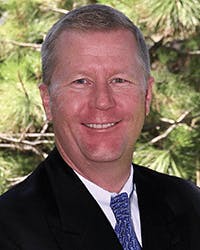Insider Insights With K-A Hegewald, VP of Network Infrastructure and Program Management, Windstream
A Q&A With One of Our ISE EXPO 2018 Tech Talk Presenters —
If you weren’t able to attend ISE EXPO 2018, you missed seeing this year’s Tech Talk presenters from TDS Telecom, Windstream, and Verizon. The good news is we convinced our Windstream presenter to share some of his insights with those readers who were unable to attend.
(You may not be so lucky next year, so save-the-date for ISE EXPO 2019: Wednesday, September 25, 2019, at the Fort Worth Convention Center, Fort Worth, Texas. Go to www.iseexpo.com for more information.)
OVERLOOKED ISSUES
What should all of us be talking about that we are not? What is the network side of the Information and Communication Technology (ICT) industry missing?
Hegewald: We should be talking about the evolution of our workforce, and how energy and security are going to play increasing roles in the expense and resiliency of our networks.
First, the change and evolution to an increasingly programmable network means we need to ensure we are training and equipping our engineers and technicians with the skills that will be needed to manage a network that will increasingly be intent-based, that leverages machine learning, and requires coding and analytical skills that can take advantage of volumes of data the network will share about its use and health.
Second, despite relatively stable energy prices over the last couple of decades, the electric utility industry may be in the beginning of a shift that could impact both consumer and large commercial customers.
At the Global Energy Forum in Beaver Creek, Colorado, last year, the CEO of a large western utility shared that his customers experienced some of the lowest electricity prices in the nation. He was challenged by another panelist who noted their electricity rates were among the highest. The difference was explained by the volume of renewables that had entered the marketplace, particularly at the consumer level, and the fact that the utility still had a large network to maintain (Sound familiar?). Thus, the utility continued to seek and obtain utility rate increases to offset revenue declines in traditional use patterns. Some other utilities are looking to exit the fiber Indefeasible Right of Use (IRU) market to remove limitations on their ability to raise rates as long they monetize their non-electrical assets; as the electrical rate opportunity is larger than their limited IRU business.
If we fail to recognize how we manage our own utility use and the efficiency of our facilities, we may begin to find an increasing cost on the expense side of the ledger.
Third, cyberattacks on infrastructure are becoming increasingly likely. Ransomware attacks on State systems in Georgia and Colorado highlight the duration and impact such an attack can impose; and a cyberattack in Kiev, Ukraine, knocked power out to that capital city for an extended time during one of the coldest days in 25 years. Our disaster preparedness focus needs to encompass non-natural disasters both to our networks and the infrastructure on which we depend.
LEARNINGS
What is the most stellar accomplishment in your career? What is a mistake you learned the most from in your many years of experience in this industry?
Hegewald: I’ve been very fortunate in my career to work with many talented, motivated individuals on high-performing teams, and have worked with some great leaders as well. Working with these individuals, we’ve been able to install and activate a transport, IP, and IT, network for a greenfield data center in just 2 weeks from facility construction completion; deploy a nationwide ultra-long-haul network not once, but 4 times; and modernize network infrastructure that helped contribute, among other efforts, to a reduction in network event impacts by 40%.
But my biggest accomplishment, while I didn’t know it at the time, was making the jump into the communications industry after building oil and gas pipelines early in my career. I have been rewarded many times over with great opportunities and relationships since that switch 18 years ago.
And my biggest learning? Thinking I could solve a large deployment problem leveraging similar approaches that had been successful previously. The paradigm had shifted. The saying What got us here won’t get us there is truer now more than ever — the changes and innovation occurring demand that we think differently and challenge the status quo to be successful.
LEADERSHIP
What is your approach to leading your teams, and how is it different than that of other leaders? Is there a "secret sauce" to your method? What advice would you give to readers who want to be on your executive team one day?
Hegewald: Humble, servant leadership is the foundation for leading, and it begins with listening. There are so many bright people on the teams we’re a part of that have great ideas, insights, and observations. And those could be missed if we don’t take the time to stop talking and listen to what they have to share.
Next, we must empower team members to make decisions, take risks, and even make mistakes — and have their backs if they stumble. Honor their victories by recognizing and crediting the efforts of individuals publicly for the achievements that enable us to meet or exceed a customer’s exacting requirements.
We must also be inclined to action rather than inaction — the sense of urgency will drive success in an organization, build confidence, and build a belief in achieving the unachievable with each new success. And when others bring us problems because they know we’ll find solutions, we know we’ve built the right kind of reputation.
Finally, never underestimate the power of a hand-written thank you note.
In all of these ways, I look to build a culture of trust, innovation, and collaboration, a culture that leads to engaged teams willing to try new and novel things and to achieve exceptional outcomes.
INSPIRATION
Share a quote from someone who inspires you.
Hegewald: One of my favorite quotes is:
"Nearly all men can stand adversity but to test a man’s character, give him power." – Abraham Lincoln
It’s a reminder to be conscious of the actions and behaviors we take, and the impact they can have on individuals. Team members key off the actions of formal and informal leaders on the team. So, transparency in direction, communication, and our motivations, truly matters.
It’s important to acknowledge the difficulties of a problematic situation and then present the confidence that together, we will develop a creative way around the challenge. This sends a positive message without discounting the reality of the obstacles to overcome. As leaders, we have to be dealers in hope, and provide the vision and direction to a better outcome than the one we may be facing.
BALANCE
What do you do to help create work/life balance in your life? How does your company encourage employees to find work/life balance?
Hegewald: It’s as difficult as ever with our connected lives to "turn-off" the work side. But it’s critical we keep at the forefront why we work as hard as we do; it’s about our families. The flip side of our connected society is that we may be better able to be available for those special moments and milestones in our family members’ lives.
For me, the outdoors has always been my refuge. I was given the gift of an active, outdoor lifestyle by my parents from the youngest age, and it’s a lifestyle I’ve been able to maintain with my own family. From skiing to hiking, cycling to kayaking, we take every available moment to be in our wonderful Rocky Mountains.
When my kids were younger, I found the unexpected benefit of coaching one or the other’s teams. That forced me to get out the door and disconnect, if only for a few hours, and focus on giving back in a different way. I carry that lesson forward, forcing myself to jump on my road bike at the end of the day to get a training ride in before the sun sets. It gives me a bit of Zen time, without distractions, to just think, or just be, as I crank away.
About the Author
Sharon Vollman
Content Ambassador for ISE EXPO
Sharon Vollman is the Content Ambassador for ISE EXPO. She is passionate about collaborating with thought leaders, SMEs and hard-working doers who design, plan and deploy ultra-reliable broadband networks. Vollman is committed to creating a variety of educational offerings for ISE EXPO attendees that inspire them to connect every U.S. citizen with the broadband networks we all want for our children and grandchildren.
Vollman has created educational partnerships with Broadband Service Providers including AT&T, Verizon, Lumen, Frontier Communications and others. She has covered the telecom industry since 1996.



